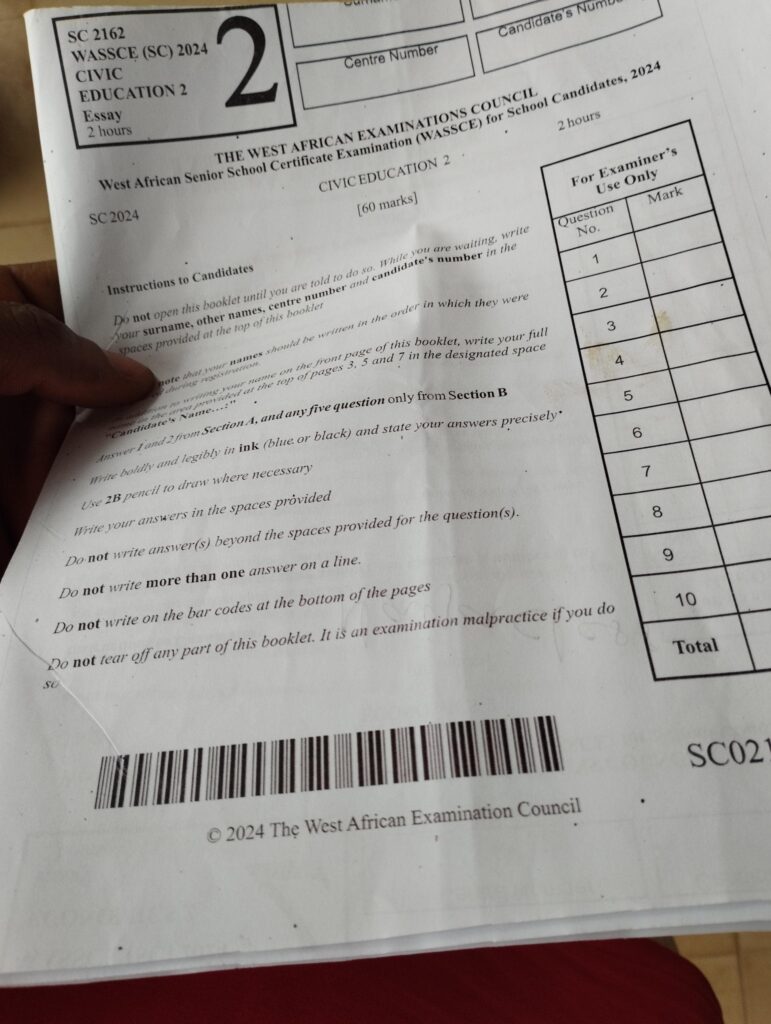Welcome to “Naijaclass Academy” For Waec Civic Education 2024 May/June Exam Answer

Date: Friday, 7th June, 2024
Civic Education (Essay & Objective) 9:30 am – 12:30 pm.
——————————
CIVIC EDUCATION OBJ:
1-10: ABABDBABAB
11-20: BDDBDDCDAC
21-30: DABBBCCBCB
31-40: ACCBABBACC
41-50: DBBCDBDBBC
NUMBER ONE
(1a)
(PICK ANY THREE)
(i) Charismatic Authority
(ii) Traditional Authority
(iii) Legal-Rational Authority
(iv) Bureaucratic Authority
(v) Moral Authority
(1b)
(PICK ANY SIX)
(i) Preservation of Culture and Tradition: Traditional leaders serve as custodians of cultural heritage and traditions, ensuring their continuity and preservation.
(ii) Conflict Resolution and Mediation: They play a vital role in resolving disputes, mediating conflicts, and maintaining social harmony within their communities.
(iii) Community Development and Empowerment: Traditional leaders often initiate and support community development projects, empowering local communities to address their own needs.
(iv) Representation and Advocacy: They represent the interests of their communities at local, regional, and national levels, advocating for their needs and aspirations.
(v) Bridge between Tradition and Modernity: Traditional leaders can bridge the gap between traditional values and modern democratic institutions, helping their communities adapt to changing times.
(vi) Role Models and Mentors: They serve as role models and mentors for younger generations, instilling values of respect, responsibility, and community engagement.
(vii) Collaboration with Formal Authorities: Traditional leaders can collaborate with elected officials and government agencies to complement and strengthen democratic governance structures.
OR
(1a)
(i) Tradition: Authority based on customs, traditions, and historical practices.
(ii) Rational-Legal: Authority based on laws, rules, and regulations.
(iii) Charisma: Authority based on an individual’s exceptional qualities, personality, or leadership abilities.
(1b)
(i) Cultural Preservation: Traditional leaders play a vital role in preserving and promoting cultural heritage, traditions, and values. They help maintain cultural identity and pass it down to future generations.
(ii) Conflict Resolution: Traditional leaders often serve as mediators and arbitrators, resolving conflicts within their communities. Their authority and wisdom help to settle disputes and maintain social harmony.
(iii) Representation: Traditional leaders represent their communities in various forums, such as local government, national assemblies, and international organizations. They voice the concerns and interests of their people.
(iv) Leadership: Traditional leaders provide guidance, direction, and inspiration to their followers. They offer vision, wisdom, and counsel, helping their communities navigate challenges and opportunities.
(v) Symbolic Role: Traditional leaders serve as symbols of unity, identity, and stability. They embody the history, values, and aspirations of their communities, providing a sense of continuity and belonging.
(vi) Community Development: Traditional leaders initiate and support development projects, promoting social and economic progress in their communities. They partner with governments, NGOs, and other stakeholders to improve healthcare, education, infrastructure, and economic opportunities.
===================================
(2a)
Community service is voluntary work performed by individuals or groups to benefit a community. It involves activities like assisting at shelters, cleaning public spaces, or organizing local events. The goal is to address community needs, promote social responsibility, and enhance the well-being of the community.
(2b)
(i) Skill Development: Community service fosters practical skills such as teamwork, communication, and leadership, which are valuable in various life situations and careers.
(ii) Personal Growth: It enhances personal qualities like empathy, responsibility, and resilience, contributing to overall character development.
(iii) Community Improvement: By addressing local needs, community service helps improve public spaces, support vulnerable populations, and enhance the quality of life for residents.
(iv) Social Connections: Volunteering builds relationships with diverse individuals and organizations, leading to a stronger sense of community and valuable networking opportunities.
(v) Career Advancement: Participation in community service provides experience that can enhance resumes, improve job prospects, and develop a professional reputation.
(vi) Health and Well-being: Engaging in community service can boost mental and emotional health by reducing stress, increasing happiness, and providing a sense of purpose and fulfillment.
===================================
Section B answered questions 4&5&6
(4) (i)Implementation of Educational Programs: Institutions can incorporate comprehensive drug education programs that inform students about the dangers of drug use, the benefits of abstaining, and healthier ways to cope with stress and emotional issues.
(ii)Counseling Services: Providing accessible mental health services and counseling can help students deal with personal issues that may lead to or exacerbate substance abuse.
(iii)Strict Enforcement of Campus Policies: Enforcing strict rules against the use and distribution of substances on campus can deter students from engaging in these activities.
(iv)Peer Support Programs: Establishing peer mentorship and support groups can help students maintain sobriety and provide a platform for sharing experiences and strategies for overcoming substance abuse.
(v)Collaboration with Law Enforcement: Institutions can collaborate with local law enforcement to manage the supply channels of illicit drugs in and around campus areas.
(5a) (i)Consistent and Correct Use of Condoms: Using condoms every time one engages in sexual activity significantly reduces the risk of transmitting or acquiring HIV.
(ii)Regular HIV Testing and Counseling: Knowing one’s HIV status and that of one’s partner can prevent transmission.
(iii)Antiretroviral Therapy (ART) for HIV-Positive Individuals: Effective ART can lower the viral load in an HIV-positive person to undetectable levels, drastically reducing the risk of transmission.
(iv)Educational Campaigns: Raising awareness about HIV transmission methods and prevention strategies can reduce stigma and encourage safer behaviors.
(v)Needle Exchange Programs: Providing clean needles for those who use intravenous drugs can prevent HIV spread among drug users.
(5b) (i)Frequent and Severe Infections: Due to weakened immune systems, individuals may experience more recurrent infections
(ii)Weight Loss and Chronic Diarrhea: Unexplained weight loss and persistent diarrhea can be common symptoms.
(iii)Fever and Night Sweats: Persistent or frequent fevers and night sweats are typical.
(iv)Fatigue: Chronic exhaustion or unexplained tiredness can occur as the body’s energy is depleted by fighting infections.
(v)Skin Rashes or Lesions: Skin problems such as rashes or lesions can be more frequent and severe in HIV-positive individuals.
(6a) (i)National Police Agency: Specifically, units that focus on crimes against persons, including trafficking.
(ii)Immigration Authorities: These bodies monitor and regulate cross-border movements to prevent illegal trafficking.
(iii)Ministry of Justice or Equivalent: Government departments that focus on legal frameworks and enforcement against trafficking.
(6b) (i)Social Stigmatization: Victims often face social stigma which can hinder their reintegration into society.
(ii)Economic Disruption: Trafficking can disrupt local economies and exploit the labor market.
(iii)Increased Public Health Concerns: Trafficking can lead to increased spread of communicable diseases among trafficked individuals.
(iv)Human Rights Violations: Severe abuse and violation of victims’ fundamental rights are common.
(v)Corruption: Trafficking can be linked to corruption at various levels, complicating efforts to combat it.
(vi)Security Issues: Human trafficking can lead to increased crime and insecurity in affected areas.
==================================================
(5a) (i) Consistent Use of Condoms: Use condoms correctly every time you have sexual intercourse to reduce the risk of HIV transmission.
(ii) Regular HIV Testing: Get tested regularly and ensure your sexual partners are tested to know your HIV status.
(iii) Pre-Exposure Prophylaxis (PrEP): Take PrEP medication if you are at high risk of HIV to lower your chances of getting infected.
(iv) Avoid Sharing Needles: Do not share needles or syringes to prevent the spread of HIV through blood.
(v) Safe Blood Transfusions: Only use blood and blood products that have been properly screened for HIV.
(5b) (i) Persistent Fever: PLWHA often experience recurring or persistent fevers without an apparent cause, signaling a compromised immune system.
(ii) Chronic Fatigue: Sufferers frequently report extreme and persistent fatigue, even after adequate rest, which can significantly affect their daily lives.
(iii) Unexplained Weight Loss: Significant and unexplained weight loss is a common symptom of HIV/AIDS, often indicating the progression of the disease.
(iv) Recurrent Infections: PLWHA are prone to frequent and severe infections, such as pneumonia, tuberculosis, or fungal infections, due to their weakened immune system.
(v) Swollen Lymph Nodes: Enlargement of lymph nodes, particularly in the neck, armpits, or groin, is a common early sign of HIV infection, as the body tries to fight off the virus.
=======================================
`
(7a) The rule of law is a fundamental principle that ensures all individuals, institutions, and government officials are subject to the law and must act in accordance with it.
(7b) (i)Independent Judiciary: A fair and impartial judiciary that can interpret laws and ensure their enforcement.
(ii)Clear and Fair Laws: Laws that are easily understood, fair, and apply equally to all citizens.
(iii)Effective Law Enforcement: Law enforcement agencies that are capable, impartial, and accountable.
(iv)Respect for Human Rights: Protection and promotion of human rights, including freedom of speech, assembly, and association.
(v)Transparency and Accountability in Government: Government actions and decisions that are transparent, accountable, and open to scrutiny.
(vi)Active and Engaged Citizenry: Citizens who are informed, participatory, and hold government officials accountable for their actions.
=======================================
(9) (i)Protection of Individual Rights and Freedoms
(ii)Separation of Powers and Checks and Balances
(iii)Distribution of Power between Federal and State Governments
(iv)Establishment of Institutions and their Powers
(v)Amendment and Revision Procedures
(i)Protection of Individual Rights and Freedoms: The constitution outlines the rights and freedoms of citizens, such as freedom of speech, religion, and assembly, and protects them from government interference.
(ii)Separation of Powers and Checks and Balances: The constitution divides power among the legislative, executive, and judicial branches, ensuring that no one branch dominates the others.
(iii)Distribution of Power between Federal and State Governments: The constitution defines the powers and responsibilities of federal and state governments, ensuring a balance of power and autonomy.
(iv)Establishment of Institutions and their Powers: The constitution establishes institutions such as the legislature, executive, and judiciary, and defines their powers and responsibilities.
(v)Amendment and Revision Procedures: The constitution outlines the procedures for amending and revising the constitution itself, ensuring that it remains a living document that can adapt to changing circumstances.


Pls we need it pls help me
I need civic 2024
Yes
Pls we need it pls help me
I need civic 2024
Yes
Sir how can I get civic questions and answer for 2024 Waec
Civic educat
ion
Yes
yes
How can I get chemistry question and answer
How can I get civic answer
Pls I need d questions
Dem me
Sir how can I get civic questions and answer for 2024 Waec
Civic educat
ion
Yes
yes
How can I get chemistry question and answer
How can I get civic answer
Pls I need d questions
Dem me
Objective/essay
Obj
Obj
Objective/essay
Obj
Obj
Pls I need both theory snd objective answers for Civic
done
Pls I need both theory snd objective answers for Civic
done
Essay and obj for civic education
How can I get chemistry question and answer
Essay and obj for civic education
How can I get chemistry question and answer
We are waiting
We are waiting
Me too
Is it possible to get the answers for 2025
Me too
Is it possible to get the answers for 2025
The waec answer
The waec answer
Sir am interested for this
Sir am interested for this
Objective
Objective
Thanks I appreciate,all answers are here
You are welcome
Thanks I appreciate,all answers are here
You are welcome
I need civic education answer
I need civic education answer
Thanks naija class you did well
Thanks naija class you did well
Thanks sir……….
You’re welcome sir
Thanks sir……….
You’re welcome sir
OBJ
OBJ
waec done and dusted
waec done and dusted
Thank u sir for love and care u shown. Thanks
Thank u sir for love and care u shown. Thanks
Thank you
Thank you
Is it possible to get the answers for 2025
Yes ,,, It is possible
Is it possible to get the answers for 2025
Yes ,,, It is possible
I want Civic education question and answer please
I want Civic education question and answer please
I need Islamic answer
I need Islamic answer
I need Islamic answer